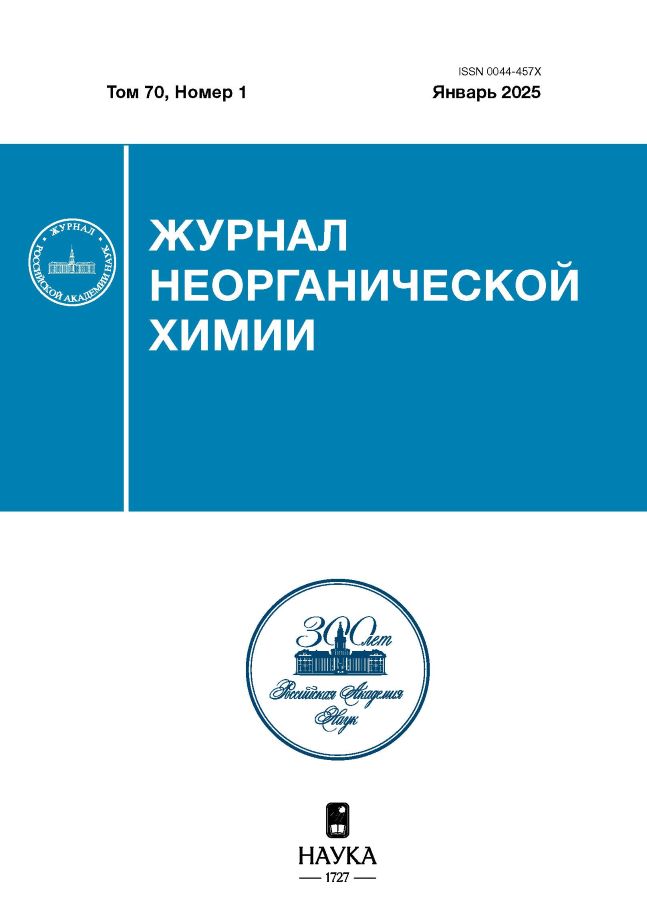The influence of the position of double bonds of unsaturated carboxylic acids on the type of the resulting coordination polymers of palladium(I)
- Autores: Efimenko I.A.1, Ivanova N.A.1, Erofeeva O.S.1, Efimov N.N.1, Demina L.I.2, Averin A.A.2, Simonenko N.P.1
-
Afiliações:
- Kurnakov Institute of General and Inorganic Chemistry of the Russian Academy of Sciences
- Frumkin Institute of Physical chemistry and Electrochemistry of the Russian Academy of Sciences
- Edição: Volume 70, Nº 1 (2025)
- Páginas: 54–62
- Seção: КООРДИНАЦИОННЫЕ СОЕДИНЕНИЯ
- URL: https://rjeid.com/0044-457X/article/view/682189
- DOI: https://doi.org/10.31857/S0044457X25010067
- EDN: https://elibrary.ru/IAYZVS
- ID: 682189
Citar
Texto integral
Resumo
For the first time in the coordination chemistry of palladium, a new class of palladium(I) polymers with unsaturated monocarboxylic acids obtained by the interaction of palladium(II) acetate Pd3(μ-MeCO2)6 with monocarboxylic 3-pentenoic and 4-pentenoic acids with a double bond not conjugated with the carboxyl group, cinnamic and crotonic acids with a double bond conjugated with the carboxyl group was isolated, and the interaction with a dicarboxylic acid (itaconic) with a double bond conjugated with only one carboxyl group, similar to cinnamic and crotonic acids, was studied. Analysis of the composition of eight newly synthesized compounds, as well as their IR, Raman and EPR spectra showed that the obtained coordination polymers of Pd(I) [Pd(RCOO)6]n with 3-pentenoic {[Pd(π-C5H7O2)] ∙ H2O}n and 4-pentenoic [Pd(π-C5H7O2) ∙ C5H8O2)]n acids are diamagnetic, and with cinnamic [Pd(C9H7O2)]n, crotonic {[Pd(C4H5O2)]H2O}n and itaconic {[Pd(C5H4O4)H2O] ∙ 2H2O}n acids they are paramagnetic. The backbone of the obtained polymers is formed by bridging carboxylate groups and Pd–Pd bonds. The completion of the coordination polyhedron in the case of complexes with 3- or 4-pentenoic acid is carried out by coordinating their double bond with palladium, in polymer complexes with cinnamic and crotonic acids - by the formed agostic bond, in complexes with itaconic acid - by a coordinated water molecule. According to EPR spectroscopy, the polymer with itaconic acid contains paramagnetic centers characterized by a content of 1018 spin/g of unpaired electrons stable for a year, which allows it to be considered as a precursor for the creation of heterogeneous catalysts with increased catalytic activity.
Texto integral
Sobre autores
I. Efimenko
Kurnakov Institute of General and Inorganic Chemistry of the Russian Academy of Sciences
Autor responsável pela correspondência
Email: ines@igic.ras.ru
Rússia, Moscow, 119991
N. Ivanova
Kurnakov Institute of General and Inorganic Chemistry of the Russian Academy of Sciences
Email: ines@igic.ras.ru
Rússia, Moscow, 119991
O. Erofeeva
Kurnakov Institute of General and Inorganic Chemistry of the Russian Academy of Sciences
Email: ines@igic.ras.ru
Rússia, Moscow, 119991
N. Efimov
Kurnakov Institute of General and Inorganic Chemistry of the Russian Academy of Sciences
Email: ines@igic.ras.ru
Rússia, Moscow, 119991
L. Demina
Frumkin Institute of Physical chemistry and Electrochemistry of the Russian Academy of Sciences
Email: ines@igic.ras.ru
Rússia, Moscow, 119991
A. Averin
Frumkin Institute of Physical chemistry and Electrochemistry of the Russian Academy of Sciences
Email: ines@igic.ras.ru
Rússia, Moscow, 119991
N. Simonenko
Kurnakov Institute of General and Inorganic Chemistry of the Russian Academy of Sciences
Email: ines@igic.ras.ru
Rússia, Moscow, 119991
Bibliografia
- Robin A., From K.M. // Coord. Chem. Rev. 2006. V. 250. P. 2127.
- Jams S. // Chem. Soc. Rev. 2003. V. 32. P. 276.
- Moulton B., Zaworotko M. // Chem. Rev. 2001. V. 101. P. 1296.
- Moulton B., Zaworotko M., Opin C. // Solid State Mater. Sci. 2002. V. 6. P. 117.
- Takamizawa S., Yamaguchi K., Mori W. // Inorg. Chem. Commun. 1998. V. 1. P. 177.
- Mori W., Hoshino H., Nishimoto Y. et al. // Chem. Lett. 1999. V. 331. P. 123.
- Mori W., Takamizawa S. // J. Solid State Chem. 2000. V. 152. P. 120.
- Mori W., Sato T., Ohmura T. et al. // J. Solid State Chem. 2005. V. 178. P. 2555.
- Sherchnev P., Kudryavtsev E. еt al. // Mater. Today: Proceeding. 2021. V. 34. P. 235.
- Brooknart M., Green M.L.H., Parkin G. // PNAS. 2007. V. 104. P. 6909.
- Sajjad M.A., Chistensen K.E., Rels N.M. et al. // Chem. Commun. 2017. V. 53. P. 4187.
- Cotton F.A., Jacour T., Stanislovski A.G. // J. Am. Chem. Soc. 1974. V. 96. P. 5074.
- Trofimenko S. // Inorg. Chem. 1970. V. 9. P. 2493.
- Sajjad M., Schwerdtfeger P., Harrison J. et al. // Polyhedron. 2018. V. 151. P. 68.
- Harrison Y., Nielson A., Sajjad A. et al. // Organomet. Chem. 2019. V. 38. P. 1903.
- Lin X., Wu W., Mo Y. // Coord. Chem. Rev. 2020. V. 419. P. 213401.
- Maggioni D., Tunzi D., Ylliano P. et al. // Inorg. Chim. Acta. 2022. V. 529. P. 120641.
- Efremenko I., Montag M. // Organometallics. 2022. V. 41. P. 2022.
- Baily N., Jenkins J., Mason R. et al. // Chem. Commun. 1965. V. 11. P. 237.
- Ibeis Y. // Abst. Am. Cryst. Assoc. 1965. V. 10. P. 34.
- Ghosh A.K., Kevan L. // J. Am. Soc. 1988. V. 110. P. 8044.
- Prakash A., Waswicz T., Kevan L. // J. Phys. Chem. 1997. V. 101. P. 11985.
- Stokes L., Murphy D., Farley P. et al. // Phys. Chem. Chem. Phys. 1999. V. 1. P. 621.
- Kikuzuno Y., Kagami S., Nauto S. et al. // Chem. Lett. 1981. V. P. 1249.
- Descorme C., Gelin P., Lewyer C. et al. // J. Catal. 1998. V. 177. P. 352.
- Бучаченко А.Л., Бердинский В.Л. // Успехи химии. 2004. Т. 73. С. 1123.
- Stromnova T.A., Monakhov K.Yu., Campora J. et al. // Inorg. Chim. Acta. 2007. V. 360. P. 4111.
- Efimenko I.A., Ankudinova P.V., Kuz’mina L.G. et al. // Russ. J. Inorg. Chem. 2015. V. 60. P. 848.
- Efimenko I.A., Erofeeva O.S., Ugolkova E.A. et al. // Mendeleev Commun. 2018. V. 28. P. 632.
- Ефименко И.А., Ефимов Н.Н., Ерофеева О.С. и др. // Коорд. химия. 2021. Т. 47. № 10. С. 640.
Arquivos suplementares
















